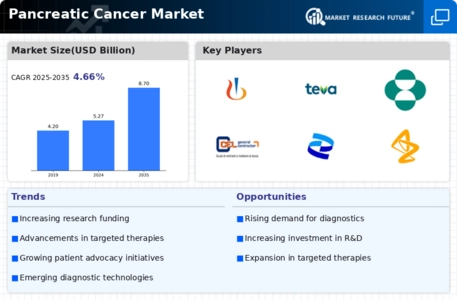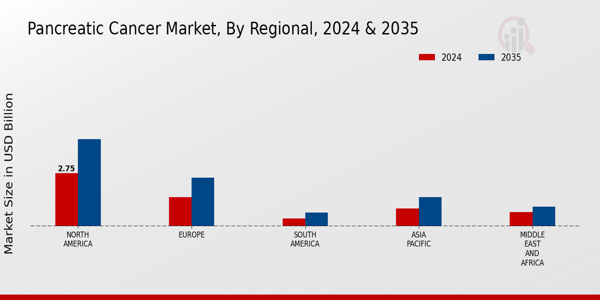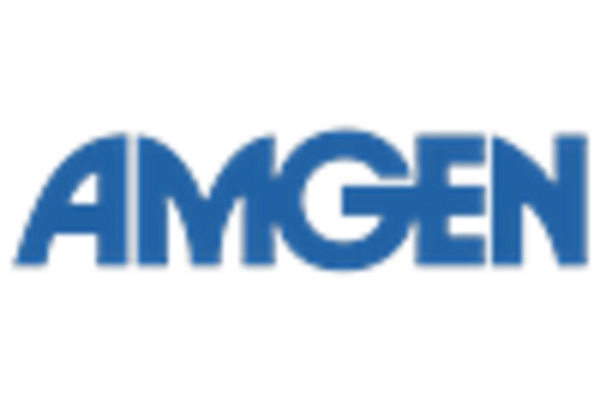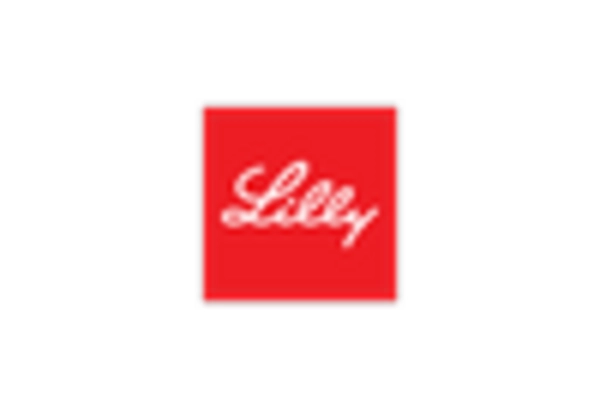Chemotherapy
Radiation Therapy
Targeted Therapy
Immunotherapy
Localized
Regional
Distant Metastatic
Hospitals
Clinics
Research Institutions
Home Care
Imaging Tests
Biopsy
Blood Tests
North America
Europe
South America
Asia Pacific
Middle East and Africa
North America Outlook (USD Billion, 2019-2035)
North America Pancreatic Cancer Market by Treatment Type
Chemotherapy
Radiation Therapy
Targeted Therapy
Immunotherapy
North America Pancreatic Cancer Market by Stage Type
Localized
Regional
Distant Metastatic
North America Pancreatic Cancer Market by End User Type
Hospitals
Clinics
Research Institutions
Home Care
North America Pancreatic Cancer Market by Diagnosis Type
Imaging Tests
Biopsy
Blood Tests
North America Pancreatic Cancer Market by Regional Type
US
Canada
US Outlook (USD Billion, 2019-2035)
US Pancreatic Cancer Market by Treatment Type
Chemotherapy
Radiation Therapy
Targeted Therapy
Immunotherapy
US Pancreatic Cancer Market by Stage Type
Localized
Regional
Distant Metastatic
US Pancreatic Cancer Market by End User Type
Hospitals
Clinics
Research Institutions
Home Care
US Pancreatic Cancer Market by Diagnosis Type
Imaging Tests
Biopsy
Blood Tests
CANADA Outlook (USD Billion, 2019-2035)
CANADA Pancreatic Cancer Market by Treatment Type
Chemotherapy
Radiation Therapy
Targeted Therapy
Immunotherapy
CANADA Pancreatic Cancer Market by Stage Type
Localized
Regional
Distant Metastatic
CANADA Pancreatic Cancer Market by End User Type
Hospitals
Clinics
Research Institutions
Home Care
CANADA Pancreatic Cancer Market by Diagnosis Type
Imaging Tests
Biopsy
Blood Tests
Europe Outlook (USD Billion, 2019-2035)
Europe Pancreatic Cancer Market by Treatment Type
Chemotherapy
Radiation Therapy
Targeted Therapy
Immunotherapy
Europe Pancreatic Cancer Market by Stage Type
Localized
Regional
Distant Metastatic
Europe Pancreatic Cancer Market by End User Type
Hospitals
Clinics
Research Institutions
Home Care
Europe Pancreatic Cancer Market by Diagnosis Type
Imaging Tests
Biopsy
Blood Tests
Europe Pancreatic Cancer Market by Regional Type
Germany
UK
France
Russia
Italy
Spain
Rest of Europe
GERMANY Outlook (USD Billion, 2019-2035)
GERMANY Pancreatic Cancer Market by Treatment Type
Chemotherapy
Radiation Therapy
Targeted Therapy
Immunotherapy
GERMANY Pancreatic Cancer Market by Stage Type
Localized
Regional
Distant Metastatic
GERMANY Pancreatic Cancer Market by End User Type
Hospitals
Clinics
Research Institutions
Home Care
GERMANY Pancreatic Cancer Market by Diagnosis Type
Imaging Tests
Biopsy
Blood Tests
UK Outlook (USD Billion, 2019-2035)
UK Pancreatic Cancer Market by Treatment Type
Chemotherapy
Radiation Therapy
Targeted Therapy
Immunotherapy
UK Pancreatic Cancer Market by Stage Type
Localized
Regional
Distant Metastatic
UK Pancreatic Cancer Market by End User Type
Hospitals
Clinics
Research Institutions
Home Care
UK Pancreatic Cancer Market by Diagnosis Type
Imaging Tests
Biopsy
Blood Tests
FRANCE Outlook (USD Billion, 2019-2035)
FRANCE Pancreatic Cancer Market by Treatment Type
Chemotherapy
Radiation Therapy
Targeted Therapy
Immunotherapy
FRANCE Pancreatic Cancer Market by Stage Type
Localized
Regional
Distant Metastatic
FRANCE Pancreatic Cancer Market by End User Type
Hospitals
Clinics
Research Institutions
Home Care
FRANCE Pancreatic Cancer Market by Diagnosis Type
Imaging Tests
Biopsy
Blood Tests
RUSSIA Outlook (USD Billion, 2019-2035)
RUSSIA Pancreatic Cancer Market by Treatment Type
Chemotherapy
Radiation Therapy
Targeted Therapy
Immunotherapy
RUSSIA Pancreatic Cancer Market by Stage Type
Localized
Regional
Distant Metastatic
RUSSIA Pancreatic Cancer Market by End User Type
Hospitals
Clinics
Research Institutions
Home Care
RUSSIA Pancreatic Cancer Market by Diagnosis Type
Imaging Tests
Biopsy
Blood Tests
ITALY Outlook (USD Billion, 2019-2035)
ITALY Pancreatic Cancer Market by Treatment Type
Chemotherapy
Radiation Therapy
Targeted Therapy
Immunotherapy
ITALY Pancreatic Cancer Market by Stage Type
Localized
Regional
Distant Metastatic
ITALY Pancreatic Cancer Market by End User Type
Hospitals
Clinics
Research Institutions
Home Care
ITALY Pancreatic Cancer Market by Diagnosis Type
Imaging Tests
Biopsy
Blood Tests
SPAIN Outlook (USD Billion, 2019-2035)
SPAIN Pancreatic Cancer Market by Treatment Type
Chemotherapy
Radiation Therapy
Targeted Therapy
Immunotherapy
SPAIN Pancreatic Cancer Market by Stage Type
Localized
Regional
Distant Metastatic
SPAIN Pancreatic Cancer Market by End User Type
Hospitals
Clinics
Research Institutions
Home Care
SPAIN Pancreatic Cancer Market by Diagnosis Type
Imaging Tests
Biopsy
Blood Tests
REST OF EUROPE Outlook (USD Billion, 2019-2035)
REST OF EUROPE Pancreatic Cancer Market by Treatment Type
Chemotherapy
Radiation Therapy
Targeted Therapy
Immunotherapy
REST OF EUROPE Pancreatic Cancer Market by Stage Type
Localized
Regional
Distant Metastatic
REST OF EUROPE Pancreatic Cancer Market by End User Type
Hospitals
Clinics
Research Institutions
Home Care
REST OF EUROPE Pancreatic Cancer Market by Diagnosis Type
Imaging Tests
Biopsy
Blood Tests
APAC Outlook (USD Billion, 2019-2035)
APAC Pancreatic Cancer Market by Treatment Type
Chemotherapy
Radiation Therapy
Targeted Therapy
Immunotherapy
APAC Pancreatic Cancer Market by Stage Type
Localized
Regional
Distant Metastatic
APAC Pancreatic Cancer Market by End User Type
Hospitals
Clinics
Research Institutions
Home Care
APAC Pancreatic Cancer Market by Diagnosis Type
Imaging Tests
Biopsy
Blood Tests
APAC Pancreatic Cancer Market by Regional Type
China
India
Japan
South Korea
Malaysia
Thailand
Indonesia
Rest of APAC
CHINA Outlook (USD Billion, 2019-2035)
CHINA Pancreatic Cancer Market by Treatment Type
Chemotherapy
Radiation Therapy
Targeted Therapy
Immunotherapy
CHINA Pancreatic Cancer Market by Stage Type
Localized
Regional
Distant Metastatic
CHINA Pancreatic Cancer Market by End User Type
Hospitals
Clinics
Research Institutions
Home Care
CHINA Pancreatic Cancer Market by Diagnosis Type
Imaging Tests
Biopsy
Blood Tests
INDIA Outlook (USD Billion, 2019-2035)
INDIA Pancreatic Cancer Market by Treatment Type
Chemotherapy
Radiation Therapy
Targeted Therapy
Immunotherapy
INDIA Pancreatic Cancer Market by Stage Type
Localized
Regional
Distant Metastatic
INDIA Pancreatic Cancer Market by End User Type
Hospitals
Clinics
Research Institutions
Home Care
INDIA Pancreatic Cancer Market by Diagnosis Type
Imaging Tests
Biopsy
Blood Tests
JAPAN Outlook (USD Billion, 2019-2035)
JAPAN Pancreatic Cancer Market by Treatment Type
Chemotherapy
Radiation Therapy
Targeted Therapy
Immunotherapy
JAPAN Pancreatic Cancer Market by Stage Type
Localized
Regional
Distant Metastatic
JAPAN Pancreatic Cancer Market by End User Type
Hospitals
Clinics
Research Institutions
Home Care
JAPAN Pancreatic Cancer Market by Diagnosis Type
Imaging Tests
Biopsy
Blood Tests
SOUTH KOREA Outlook (USD Billion, 2019-2035)
SOUTH KOREA Pancreatic Cancer Market by Treatment Type
Chemotherapy
Radiation Therapy
Targeted Therapy
Immunotherapy
SOUTH KOREA Pancreatic Cancer Market by Stage Type
Localized
Regional
Distant Metastatic
SOUTH KOREA Pancreatic Cancer Market by End User Type
Hospitals
Clinics
Research Institutions
Home Care
SOUTH KOREA Pancreatic Cancer Market by Diagnosis Type
Imaging Tests
Biopsy
Blood Tests
MALAYSIA Outlook (USD Billion, 2019-2035)
MALAYSIA Pancreatic Cancer Market by Treatment Type
Chemotherapy
Radiation Therapy
Targeted Therapy
Immunotherapy
MALAYSIA Pancreatic Cancer Market by Stage Type
Localized
Regional
Distant Metastatic
MALAYSIA Pancreatic Cancer Market by End User Type
Hospitals
Clinics
Research Institutions
Home Care
MALAYSIA Pancreatic Cancer Market by Diagnosis Type
Imaging Tests
Biopsy
Blood Tests
THAILAND Outlook (USD Billion, 2019-2035)
THAILAND Pancreatic Cancer Market by Treatment Type
Chemotherapy
Radiation Therapy
Targeted Therapy
Immunotherapy
THAILAND Pancreatic Cancer Market by Stage Type
Localized
Regional
Distant Metastatic
THAILAND Pancreatic Cancer Market by End User Type
Hospitals
Clinics
Research Institutions
Home Care
THAILAND Pancreatic Cancer Market by Diagnosis Type
Imaging Tests
Biopsy
Blood Tests
INDONESIA Outlook (USD Billion, 2019-2035)
INDONESIA Pancreatic Cancer Market by Treatment Type
Chemotherapy
Radiation Therapy
Targeted Therapy
Immunotherapy
INDONESIA Pancreatic Cancer Market by Stage Type
Localized
Regional
Distant Metastatic
INDONESIA Pancreatic Cancer Market by End User Type
Hospitals
Clinics
Research Institutions
Home Care
INDONESIA Pancreatic Cancer Market by Diagnosis Type
Imaging Tests
Biopsy
Blood Tests
REST OF APAC Outlook (USD Billion, 2019-2035)
REST OF APAC Pancreatic Cancer Market by Treatment Type
Chemotherapy
Radiation Therapy
Targeted Therapy
Immunotherapy
REST OF APAC Pancreatic Cancer Market by Stage Type
Localized
Regional
Distant Metastatic
REST OF APAC Pancreatic Cancer Market by End User Type
Hospitals
Clinics
Research Institutions
Home Care
REST OF APAC Pancreatic Cancer Market by Diagnosis Type
Imaging Tests
Biopsy
Blood Tests
South America Outlook (USD Billion, 2019-2035)
South America Pancreatic Cancer Market by Treatment Type
Chemotherapy
Radiation Therapy
Targeted Therapy
Immunotherapy
South America Pancreatic Cancer Market by Stage Type
Localized
Regional
Distant Metastatic
South America Pancreatic Cancer Market by End User Type
Hospitals
Clinics
Research Institutions
Home Care
South America Pancreatic Cancer Market by Diagnosis Type
Imaging Tests
Biopsy
Blood Tests
South America Pancreatic Cancer Market by Regional Type
Brazil
Mexico
Argentina
Rest of South America
BRAZIL Outlook (USD Billion, 2019-2035)
BRAZIL Pancreatic Cancer Market by Treatment Type
Chemotherapy
Radiation Therapy
Targeted Therapy
Immunotherapy
BRAZIL Pancreatic Cancer Market by Stage Type
Localized
Regional
Distant Metastatic
BRAZIL Pancreatic Cancer Market by End User Type
Hospitals
Clinics
Research Institutions
Home Care
BRAZIL Pancreatic Cancer Market by Diagnosis Type
Imaging Tests
Biopsy
Blood Tests
MEXICO Outlook (USD Billion, 2019-2035)
MEXICO Pancreatic Cancer Market by Treatment Type
Chemotherapy
Radiation Therapy
Targeted Therapy
Immunotherapy
MEXICO Pancreatic Cancer Market by Stage Type
Localized
Regional
Distant Metastatic
MEXICO Pancreatic Cancer Market by End User Type
Hospitals
Clinics
Research Institutions
Home Care
MEXICO Pancreatic Cancer Market by Diagnosis Type
Imaging Tests
Biopsy
Blood Tests
ARGENTINA Outlook (USD Billion, 2019-2035)
ARGENTINA Pancreatic Cancer Market by Treatment Type
Chemotherapy
Radiation Therapy
Targeted Therapy
Immunotherapy
ARGENTINA Pancreatic Cancer Market by Stage Type
Localized
Regional
Distant Metastatic
ARGENTINA Pancreatic Cancer Market by End User Type
Hospitals
Clinics
Research Institutions
Home Care
ARGENTINA Pancreatic Cancer Market by Diagnosis Type
Imaging Tests
Biopsy
Blood Tests
REST OF SOUTH AMERICA Outlook (USD Billion, 2019-2035)
REST OF SOUTH AMERICA Pancreatic Cancer Market by Treatment Type
Chemotherapy
Radiation Therapy
Targeted Therapy
Immunotherapy
REST OF SOUTH AMERICA Pancreatic Cancer Market by Stage Type
Localized
Regional
Distant Metastatic
REST OF SOUTH AMERICA Pancreatic Cancer Market by End User Type
Hospitals
Clinics
Research Institutions
Home Care
REST OF SOUTH AMERICA Pancreatic Cancer Market by Diagnosis Type
Imaging Tests
Biopsy
Blood Tests
MEA Outlook (USD Billion, 2019-2035)
MEA Pancreatic Cancer Market by Treatment Type
Chemotherapy
Radiation Therapy
Targeted Therapy
Immunotherapy
MEA Pancreatic Cancer Market by Stage Type
Localized
Regional
Distant Metastatic
MEA Pancreatic Cancer Market by End User Type
Hospitals
Clinics
Research Institutions
Home Care
MEA Pancreatic Cancer Market by Diagnosis Type
Imaging Tests
Biopsy
Blood Tests
MEA Pancreatic Cancer Market by Regional Type
GCC Countries
South Africa
Rest of MEA
GCC COUNTRIES Outlook (USD Billion, 2019-2035)
GCC COUNTRIES Pancreatic Cancer Market by Treatment Type
Chemotherapy
Radiation Therapy
Targeted Therapy
Immunotherapy
GCC COUNTRIES Pancreatic Cancer Market by Stage Type
Localized
Regional
Distant Metastatic
GCC COUNTRIES Pancreatic Cancer Market by End User Type
Hospitals
Clinics
Research Institutions
Home Care
GCC COUNTRIES Pancreatic Cancer Market by Diagnosis Type
Imaging Tests
Biopsy
Blood Tests
SOUTH AFRICA Outlook (USD Billion, 2019-2035)
SOUTH AFRICA Pancreatic Cancer Market by Treatment Type
Chemotherapy
Radiation Therapy
Targeted Therapy
Immunotherapy
SOUTH AFRICA Pancreatic Cancer Market by Stage Type
Localized
Regional
Distant Metastatic
SOUTH AFRICA Pancreatic Cancer Market by End User Type
Hospitals
Clinics
Research Institutions
Home Care
SOUTH AFRICA Pancreatic Cancer Market by Diagnosis Type
Imaging Tests
Biopsy
Blood Tests
REST OF MEA Outlook (USD Billion, 2019-2035)
REST OF MEA Pancreatic Cancer Market by Treatment Type
Chemotherapy
Radiation Therapy
Targeted Therapy
Immunotherapy
REST OF MEA Pancreatic Cancer Market by Stage Type
Localized
Regional
Distant Metastatic
REST OF MEA Pancreatic Cancer Market by End User Type
Hospitals
Clinics
Research Institutions
Home Care
REST OF MEA Pancreatic Cancer Market by Diagnosis Type
Imaging Tests
Biopsy
Blood Tests










Leave a Comment